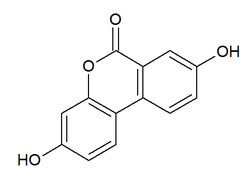Urolithin

Urolithins are microflora human metabolites of dietary ellagic acid derivatives[1] such as ellagitannins. They are produced in the human gut, and found in the urine in the form of urolithin B glucuronide after absorption of ellagitannins-containing food such as pomegranate,[2] strawberries, red raspberries, walnuts or oak-aged red wine.[3]
During intestinal metabolism by bacteria, ellagitannins and punicalagins are converted to urolithins, which have unknown biological activity in vivo in humans.[2][4] Urolithins metabolites of pomegranate juice ellagitannins localize specifically in the prostate gland, colon, and intestinal tissues of mice,[5] leading to clinical studies of pomegranate juice or fruit extracts for efficacy against several diseases.
Ellagitannins exhibit low bioavailability and are transformed in the gut to ellagic acid and its microbiota metabolites. Urolithins are found in plasma mostly as glucuronides at low concentrations.[6]
Urolithins production is dependent on the gut microbiome enterotype. Individuals producing urolithins show a much higher abundance of the Clostridium leptum group of Firmicutes phylum than Bacteroides or Prevotella.[7]
Urolithin M7 has also been synthetized from 2-hydroxy-4-methoxybenzaldehyde using the inverse electron-demand Diels–Alder reaction.[8]
Known molecules
- Urolithin A (3,8-Dihydroxyurolithin)
- Urolithin A glucuronide
- Urolithin B (3-Hydroxyurolithin)
- urolithin B glucuronide
- Urolithin D (3,4,8,9-Tetrahydroxyurolithin)
catabolic intermediates:
- Urolithin M-5
- Urolithin M-6
- Urolithin M-7
- Urolithin C (3,8,9-Trihydroxy urolithin)
- Urolithin E (2,3,8,10-Tetrahydroxy urolithin)
See also
References
- ↑ Larrosa, M; González-Sarrías, A; García-Conesa, MT; Tomás-Barberán, FA; Espín, JC (2006). "Urolithins, ellagic acid-derived metabolites produced by human colonic microflora, exhibit estrogenic and antiestrogenic activities". Journal of Agricultural and Food Chemistry 54 (5): 1611–1620. doi:10.1021/jf0527403. PMID 16506809.
- ↑ 2.0 2.1 Bialonska D, Kasimsetty SG, Khan SI, Ferreira D (11 November 2009). "Urolithins, intestinal microbial metabolites of Pomegranate ellagitannins, exhibit potent antioxidant activity in a cell-based assay". J Agric Food Chem 57 (21): 10181–6. doi:10.1021/jf9025794. PMID 19824638.
- ↑ Cerdá, Begoña; Tomás-Barberán, Francisco A.; Espín, Juan Carlos (2005). "Metabolism of Antioxidant and Chemopreventive Ellagitannins from Strawberries, Raspberries, Walnuts, and Oak-Aged Wine in Humans: Identification of Biomarkers and Individual Variability". Journal of Agricultural and Food Chemistry 53 (2): 227–235. doi:10.1021/jf049144d. PMID 15656654.
- ↑ Larrosa M, González-Sarrías A, Yáñez-Gascón MJ, Selma MV, Azorín-Ortuño M, Toti S, Tomás-Barberán F, Dolara P, Espín JC (19 July 2009). "Anti-inflammatory properties of a pomegranate extract and its metabolite urolithin-A in a colitis rat model and the effect of colon inflammation on phenolic metabolism". J Nutr Biochem 21 (8): 717–25. doi:10.1016/j.jnutbio.2009.04.012. PMID 19616930.
- ↑ Seeram NP; Aronson WJ; Zhang Y et al. (September 2007). "Pomegranate ellagitannin-derived metabolites inhibit prostate cancer growth and localize to the mouse prostate gland". J. Agric. Food Chem. 55 (19): 7732–7. doi:10.1021/jf071303g. PMID 17722872.
|first10=missing|last10=in Authors list (help);|first11=missing|last11=in Authors list (help) - ↑ Giménez-Bastida, Juan A.; González-Sarrías, Antonio; Larrosa, Mar; Tomás-Barberán, Francisco; Espín, Juan C.; García-Conesa, María-Teresa (2012). "Ellagitannin metabolites, urolithin a glucuronide and its aglycone urolithin A, ameliorate TNF-α-induced inflammation and associated molecular markers in human aortic endothelial cells". Molecular Nutrition & Food Research 56 (5): 784–796. doi:10.1002/mnfr.201100677.
- ↑ García-Villalba, Rocío; Beltrán, David; Espín, Juan Carlos; Selma, María Victoria; Tomás-Barberán, Francisco A. (2013). "Time Course Production of Urolithins from Ellagic Acid by Human Gut Microbiota". Journal of Agricultural and Food Chemistry 61 (37): 8797–8806. doi:10.1021/jf402498b. PMID 23984796.
- ↑ Bodwell, Graham; Pottie, Ian; Nandaluru, Penchal (2011). "An Inverse Electron-Demand Diels-Alder-Based Total Synthesis of Urolithin M7". Synlett 2011 (15): 2245–2247. doi:10.1055/s-0030-1261203.
| ||||||||||||||||||||||||||||||||||||||